 Technology
Technology  Technology
Technology  Humans
Humans 10 Everyday Human Behaviors That Are Actually Survival Instincts
 Animals
Animals 10 Animals That Humiliated and Harmed Historical Leaders
 History
History 10 Most Influential Protests in Modern History
 Creepy
Creepy 10 More Representations of Death from Myth, Legend, and Folktale
 Technology
Technology 10 Scientific Breakthroughs of 2025 That’ll Change Everything
 Our World
Our World 10 Ways Icelandic Culture Makes Other Countries Look Boring
 Misconceptions
Misconceptions 10 Common Misconceptions About the Victorian Era
 Mysteries
Mysteries 10 Strange Unexplained Mysteries of 2025
 Miscellaneous
Miscellaneous 10 of History’s Most Bell-Ringing Finishing Moves
 Technology
Technology Top 10 Everyday Tech Buzzwords That Hide a Darker Past
 Humans
Humans 10 Everyday Human Behaviors That Are Actually Survival Instincts
 Animals
Animals 10 Animals That Humiliated and Harmed Historical Leaders
Who's Behind Listverse?

Jamie Frater
Head Editor
Jamie founded Listverse due to an insatiable desire to share fascinating, obscure, and bizarre facts. He has been a guest speaker on numerous national radio and television stations and is a five time published author.
More About Us History
History 10 Most Influential Protests in Modern History
 Creepy
Creepy 10 More Representations of Death from Myth, Legend, and Folktale
 Technology
Technology 10 Scientific Breakthroughs of 2025 That’ll Change Everything
 Our World
Our World 10 Ways Icelandic Culture Makes Other Countries Look Boring
 Misconceptions
Misconceptions 10 Common Misconceptions About the Victorian Era
 Mysteries
Mysteries 10 Strange Unexplained Mysteries of 2025
 Miscellaneous
Miscellaneous 10 of History’s Most Bell-Ringing Finishing Moves
10 Reasons Hummingbirds Are Absolutely Astounding
Across the Americas, buzzing winged projectiles streak around backyards searching for sugar. All summer long, they dip and dive through their aerial acrobatics, occasionally sipping from brightly colored bird feeders. Hummingbirds only live in the western hemisphere, but they are an iconic family due to their beauty and uniqueness. They drink nectar from flowers with their unmistakable long, needle-like beaks fueling an incredibly high metabolism that requires a massive amount of caloric intake. They’re the only bird in the world that can hover and fly backward. Which is all fascinating stuff, but if you think that even scratches the surface, then prepare to be amazed. Hummingbirds may just be the most astounding avians on the planet. And the weirdest.
10Face Swords
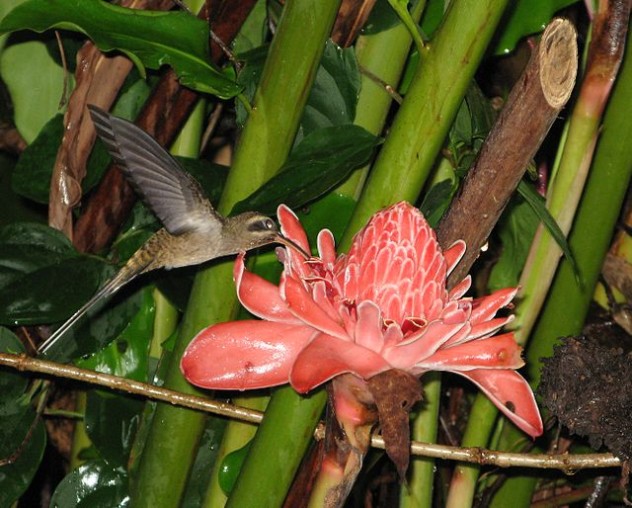
We all know that hummingbirds use their long, narrow beaks to reach deep into flowers to drink their nectar. The bird gets dinner, and the flower gets pollinated. At first, scientists believed flower shape led to the development of those narrow, needle-like bills, but now this is being reconsidered. Maybe the hummingbirds grew the beaks first and the flowers adapted to the birds. So, why did hummingbirds evolve these long, thin beaks? Scientists studied the long-billed hermit hummingbird and found that the reasoning is that so males can stab each other.
Research has shown that when males become adults their beaks become longer and sharper than the females. It turns out that the beautiful little birds zipping about your garden may be trying to jab their sword-like bills into each other. This is how males settle territorial disputes. When a female is around, a male hummingbird will woo her, but he can’t do that until he ejects all the other guys in the area. So a good bout of aerial face-dagger fencing is in order. The winner then gets to do a little dance for the ladies. The loser gets a beak shank to the throat. No other bird is known to use its bill to stab its rivals like this.
9Super Flight
Hummingbirds are fast and agile, but few people appreciate just how aerodynamically perfect these little speedsters are. Researchers at Stanford University compared 12 hummingbirds with one of the smallest drones in the world, the Black Hornet Nano, which is used by the military for reconnaissance. A helicopter should be much more efficient than a bird at hovering, but most of the species “performed similarly to the tiny drone.” But one species, the Calypte anna, demonstrated that its wings “were 22 percent more efficient than the drone’s rotor blades.”
Part of the reason for the hummingbird’s flying prowess comes from the fact that it flies more like an insect than a bird. When a normal bird flies, it relies on the downstroke of its wings to provide lift. Hummingbirds, like insects, get lift from not only the downstroke but also the upstroke. Specifically, “75 percent of the bird’s weight is supported by the down stroke, while the other 25 percent is lifted by the up stroke.” They do this by inverting their wings on the upstroke. And the upstroke is equally as aerodynamically efficient as the downstroke; they just put more power into the downstroke so it lifts more. That’s one of the reasons this is the only bird that can hover and fly backward and upside-down.
8Daredevil Musicians
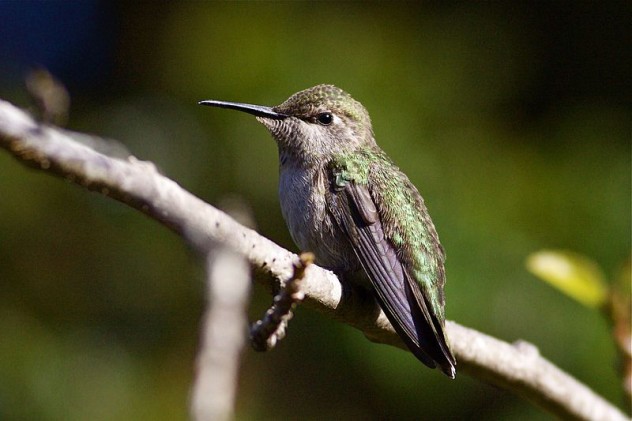
The Anna’s hummingbird is, relative to body size, the fastest bird in the world. While the peregrine falcon can dive at 320 kilometers per hour (200 mph), it’s only moving at 200 body lengths a second. The Anna’s hummingbird only flies at 80 kilometers per hour (50 mph), but travels 385 of its own body lengths per second. That’s also relatively faster than fighter jets which only cover about 39 of their lengths a second.
When these little birds pull out of their dives, they’re experiencing 10 Gs. The only other creatures that do that are fighter pilots, who can black out at 7 Gs. But why do they throw themselves into these death-defying dives? To make music for the ladies, of course. As they plummet, their tail feathers vibrate making a chirping noise. Not only does this screaming death-dive get the ladies’ attention, but the chirping noise coming from the tail feathers can’t be faked. Only the healthiest males can pull off this stunt producing the sound. It’s an extremely accurate way for a discriminating female to judge a potential mate. If he can’t plummet to the Earth at relative speeds faster than a jet pulling enough Gs to kill a man, thereby making his tail feathers chirp, then he can’t get the girl.
7Can Burn Multiple Types Of Fuel Efficiently
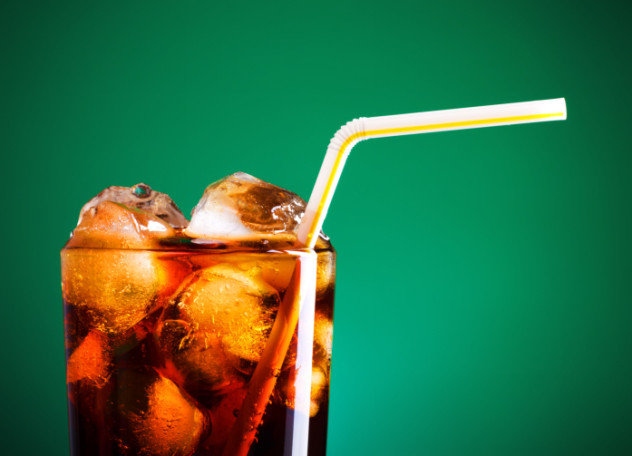
Hummingbirds burn a lot of energy with all their zipping around, flying upside-down, and plummeting to the Earth in death dives. “[If] a hummingbird were the size of a human, it would consume energy at a rate more than 10 times that of an Olympic marathon runner.” To help get all the energy they can out of their food, hummingbirds have an adaptation unique among vertebrates. They can burn both fructose and glucose with equal efficiency.
Humans can’t do that. Fructose and glucose are the two main sugars we ingest. Fructose comes primarily from fruit while glucose comes from starch. While the body can turn glucose directly into energy, only 1 percent of the fructose we ingest can be used immediately. The rest has to be sent to the liver to be processed. Some of that fructose is turned into glucose and some into fat. Most soft drinks are sweetened with high fructose corn syrup which puts a toll on our livers. It also makes us fat.
Hummingbirds can drink all the fructose they want without getting fat because it goes straight to their muscles as fuel “because hummingbirds burn sugar so fast that if they were the size of an average person they would need to drink more than one can of soda every minute even though it’s mostly made of high-fructose corn syrup.” Scientists aren’t sure yet exactly how they can do this, but everyone admits that it’s a feat worthy of envy. Imagine if you could get most of your energy requirements by downing your favorite sugary carbonated beverage.
Note: This does not mean you should feed a hummingbird something other than the accepted recipe for hummingbird food. Feeding a hummingbird something like soda pop could be dangerous or even deadly for the bird.
6Never Forgets
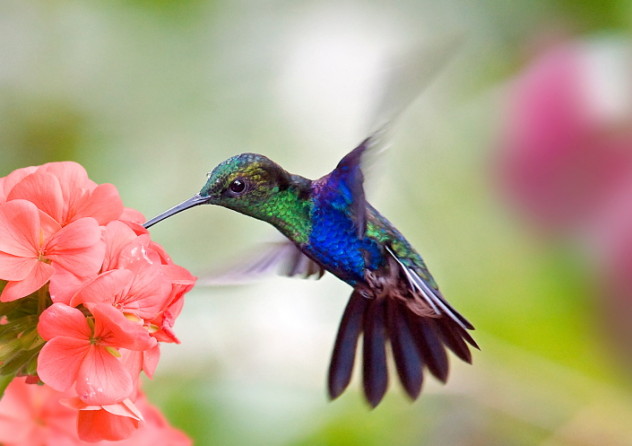
Hummingbirds have a high-energy lifestyle where they burn a lot of fuel. This hyperactive bird will have to slurp down the nectar of hundreds of flowers a day to survive. Fortunately, they’ve got a terrific memory. In fact, their hippocampal formation, the part of the brain responsible for learning and memory, is huge. It is between two to five times larger than any other bird.
They’re very smart birds and they can remember the exact location of every flower in their territory and how long it takes for that flower to refill after they’ve fed on it. With this superb memory, they can plan out their feeding route with maximum efficiency. Lots of animals can remember what they saw, but it’s never been demonstrated that any of them can remember when they saw it. It was thought only people could do that. Now it’s known that not only can hummingbirds accurately keep track of where their flowers are and how long it takes them to refill, but they can do all this while fighting off rivals and showing off for the ladies.
5Plants Recognize Hummingbirds
![]()
Plants can actually be very picky about who pollinates them. Some prefer bees and some prefer birds. The advantage of having hummingbirds as pollinators is they can operate in conditions and over ranges that bees can’t. For instance, bees are no good in cold weather or in the rain. But how does a mere plant choose who it works with? Well for starters there are “anti-bee” mechanisms that it will employ. Lack of a scent, for instance. Bees work from scent where hummingbirds don’t have a sense of smell and are drawn primarily by color. And the color red seems to be the most popular color for plants that want to draw in birds. That’s probably because bees can’t see red. Plants will go to even greater lengths, such as creating flowers that are long and narrow that insects have trouble getting into. But certain hummingbird bills will fit them like a key into a lock.
Heliconia tortuosa has to go even further, though. This plant won’t start germinating unless it’s visited by one of two specific species of hummingbirds: violet sabrewings or green hermits. In fact, scientists were having trouble breeding the plants in a lab, which is how they discovered this mechanism. But when violet sabrewings and green hermits visit, there is an 80 percent chance they will successfully fertilize the plant.
These two hummingbird species are both wide ranging, which probably helps Heliconia tortuosa spread its genes farther. So, how does a plant recognize a bird? Heliconia tortuosa has deep flowers. When other pollinators come by, they can only reach some of the nectar. Sabrewings and green hermits have longer bills and can suck it all up. This alerts the plant that they’ve got one of their favorite birds locked on.
4Strange Tastes
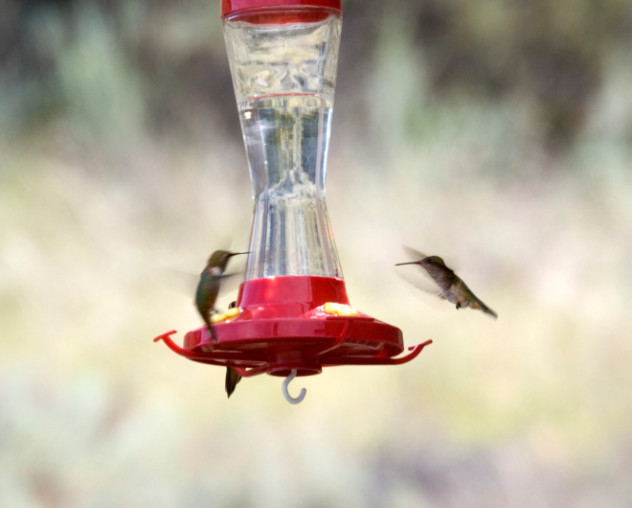
We can taste sweet, salty, sour, bitter, and umami (the relatively newly discovered taste that detects savory flavors, including meats and cheeses). Birds can’t taste anything sweet, though. But, of course, cats don’t respond to sweetness, either. There are lots of animals that have a reduced sense of taste in particular areas. Birds are a little unique, though. It’s not that they have fewer sweet receptors. They genetically do not possess the ability to taste anything sweet.
There is only one known piece of DNA in vertebrates that deals with the ability to taste sweetness, and birds don’t have it. Which makes you wonder: How do nectar-loving hummingbirds know what “sweet” tastes like? After years of research, it was discovered that a hummingbird’s umami sense has changed to detect sweets and carbohydrates, which is no easy trick. According to one researcher, “Amino acids and sugars look very different structurally so in order to recognize them and sense them in the environment, you need a completely different lock and key. The key looks very different, so you have to change the lock almost entirely.” Hummingbirds taste sweetness with the sense we use to taste meat. So the real question is: Does nectar taste like gravy to them?
3Super Tongues
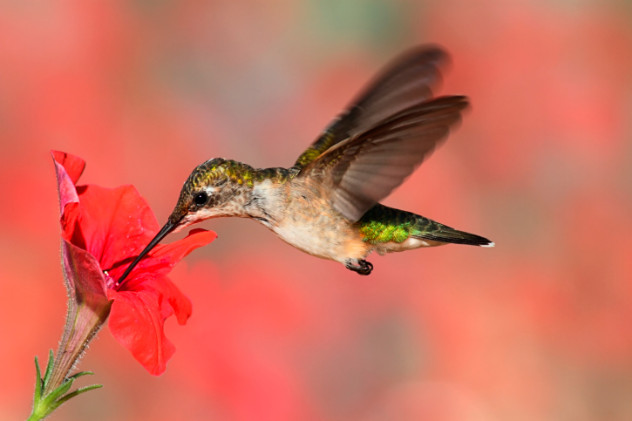
Hummingbirds might have the most efficient and weirdest tongues on the planet. But, of course, when you have to lick up 14 times your weight in the course of a single day, your tongue needs to run better than a Ferrari. A hummingbird tongue can flick out 20 times a second and in some species is so long that it wraps around its skull.
It’s also forked, kind of like a snake, but weirder. Their forked tongues are lined with hair-like extensions called lamellae. It had been assumed that capillary action alone accounted for how hummingbirds drank. (You can see an example of capillary action when you set a sponge in a puddle and it sucks up all the water.) But this model can only describe how they drink from the surface of a liquid. Another problem is that capillary action only works effectively with watery nectar. The really sugary stuff that hummingbirds prefer is too viscous for this method to work well. It was discovered recently that when a hummingbird submerges its tongue into nectar, the lamellae flare out all on their own. When the tongue is then retracted, the lamellae trap the liquid which is then drawn into the mouth. This bird has a mop-net tongue that can slurp down seven mouthfuls of syrup faster than you can blink.
2Trap Jaws
One cannot subsist on super sugary drinks alone. Not even hummingbirds can. They need to get protein and other nutrients, too, so they eat bugs. A lot of bugs—the equivalent of 300 fruit flies a day. To accomplish this, they’ve got a few special tricks. The first problem is that their bills are long and needle-like. That’s not an ideal shape for catching bugs. The solution is to widen it. Fortunately, their bills are made of thin, flexible bones. Special muscles in their jaw cause the bill to twist and bend outward, widening as the mouth is opened. This creates a larger catcher’s mitt to snag bugs with.
But this adaptation isn’t all they’re equipped with. Hummingbirds use stored-up elastic force to snap their jaws closed faster than would be possible with muscle strength alone. Snap-buckling describes the phenomenon which is “similar to the opening and closing of a snap hair clip.” Basically, the hummingbird cocks its beak open and then snaps it shut within a hundredth of a second. This way, it can snatch up even the quickest little insects. Snap-buckling is not new in nature; Venus flytraps and cicadas use it too, but hummingbirds are the only vertebrates discovered to use this mechanism.
1Torpor
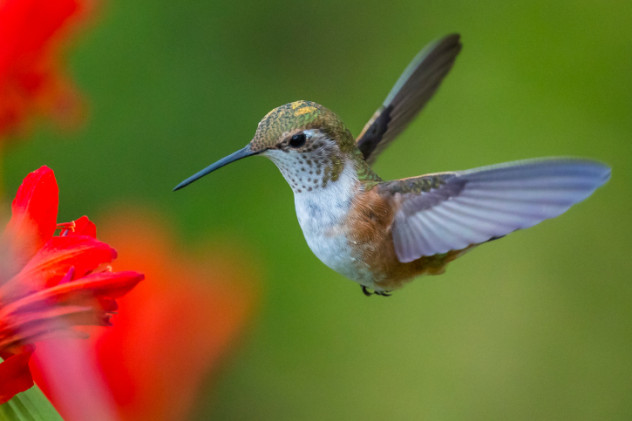
For hummingbirds, maintaining energy levels is crucial. Especially because hummingbirds are the smallest warm-blooded creatures in the world with the highest metabolism in the world. Small animals lose body heat fast. Even sleeping hummingbirds burn a ton of calories. Add to that the fact that their feathers are poor insulators and a single cool night can mean death.
To compensate, hummingbirds can go into suspended animation whenever they need to. It’s called “torpor,” and it’s just like hibernation except that hibernation lasts for a season whereas hummingbirds can shut down just for the night. Lots of animals can hibernate, but hummingbirds are one of the few vertebrates that can go into torpor any night of the year. If a cold spell comes through, they can just turn all non-vital systems off, reducing their metabolic rate by as much as 95 percent. They consume 50 percent less energy when torpid, and they can lower their body temperature to the “hypothermic threshold that is barely sufficient to maintain life.” They can hover at the line of hypothermia and death on demand.
Monte Richard II has several animal articles floating around the Internet. He also writes about his latest gaming obsession at TryHardArena.com.








